Feasibility Report: Developing a Fruit Processing Business in Thailand
VerifiedAdded on 2021/05/31
|12
|2367
|110
Report
AI Summary
This report presents a detailed analysis of a business idea: a fruit processing plant in Bangkok, Thailand. The report begins with an executive summary, highlighting the market gap in Thailand for fruit products and the potential benefits of the business, including job creation and economic growth. The introduction outlines the importance of a well-defined business idea, followed by an analysis of the market problem and the rationale for choosing Thailand as the location due to the availability of raw materials and a ready market. The report then details the benefits of the business, including job creation, improved living standards, and sustainability. The proposed business model, based on unbundling, is described, including customer segmentation, value propositions, and revenue streams. Critical success factors, such as a skilled workforce, legal compliance, and strong customer relations, are discussed. The report concludes with an evaluation of market and commercial feasibility, emphasizing the business's potential for success. References and an appendix, including a business model canvas, are included.
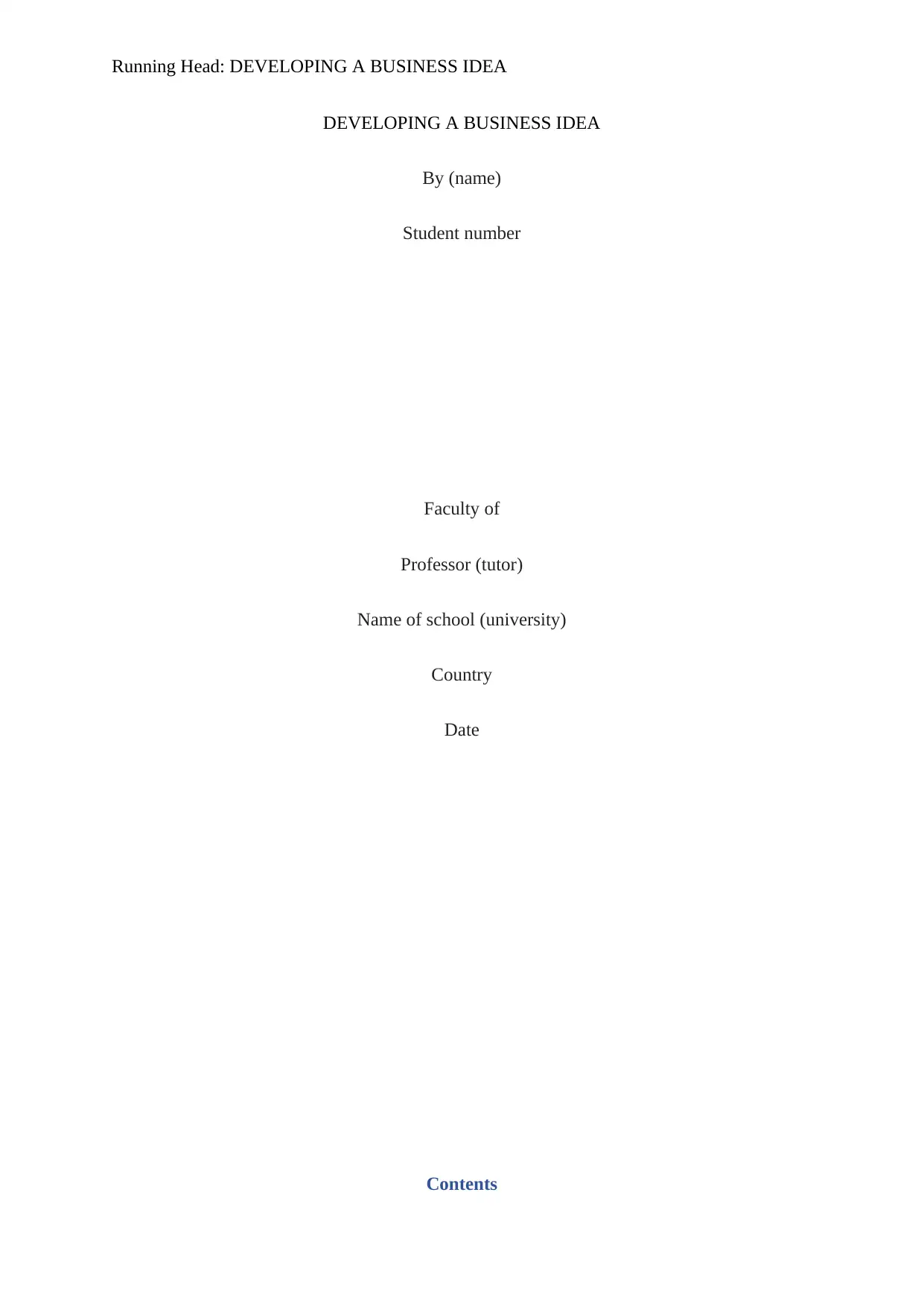
Running Head: DEVELOPING A BUSINESS IDEA
DEVELOPING A BUSINESS IDEA
By (name)
Student number
Faculty of
Professor (tutor)
Name of school (university)
Country
Date
Contents
DEVELOPING A BUSINESS IDEA
By (name)
Student number
Faculty of
Professor (tutor)
Name of school (university)
Country
Date
Contents
Paraphrase This Document
Need a fresh take? Get an instant paraphrase of this document with our AI Paraphraser
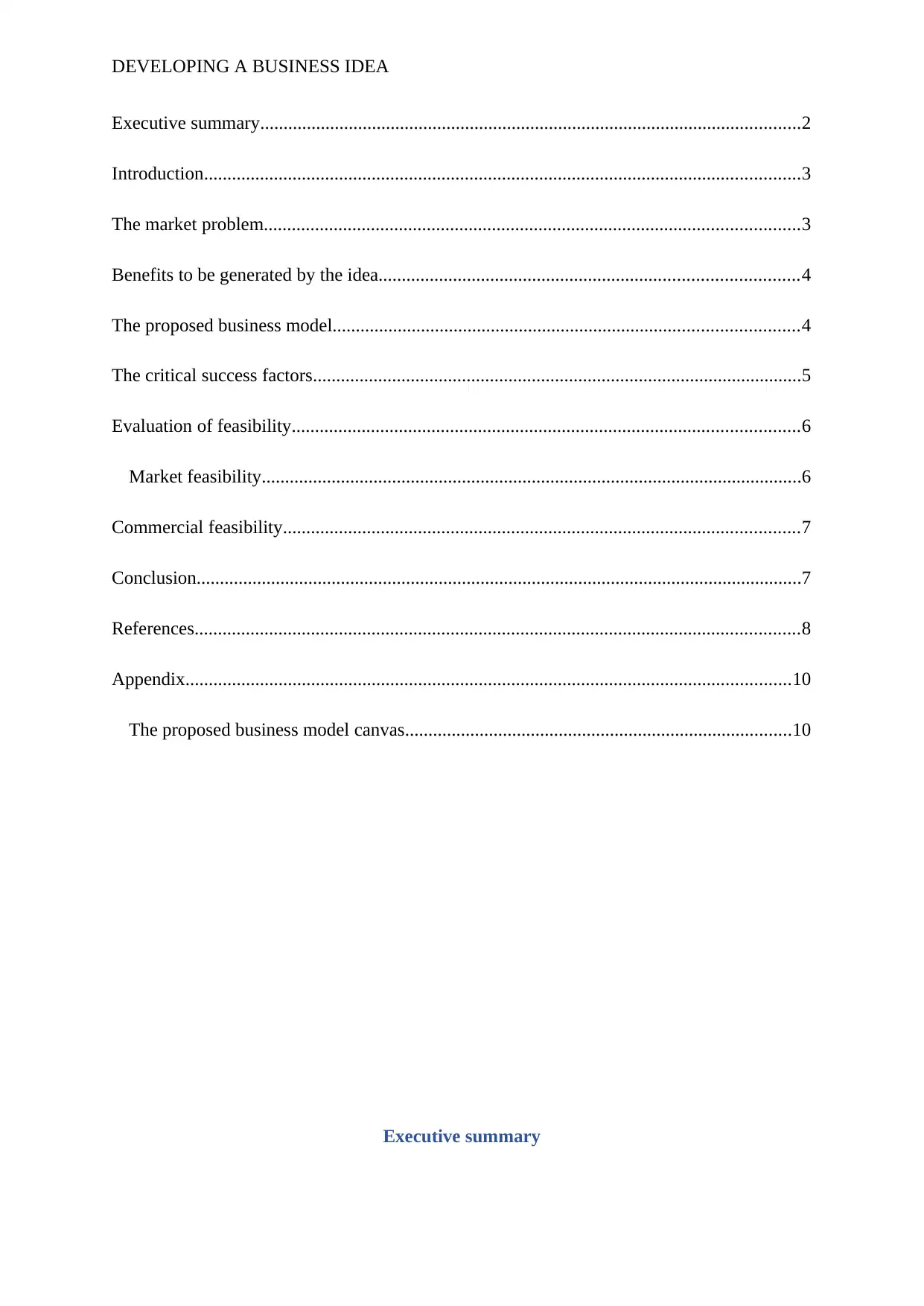
DEVELOPING A BUSINESS IDEA
Executive summary....................................................................................................................2
Introduction................................................................................................................................3
The market problem...................................................................................................................3
Benefits to be generated by the idea..........................................................................................4
The proposed business model....................................................................................................4
The critical success factors.........................................................................................................5
Evaluation of feasibility.............................................................................................................6
Market feasibility....................................................................................................................6
Commercial feasibility...............................................................................................................7
Conclusion..................................................................................................................................7
References..................................................................................................................................8
Appendix..................................................................................................................................10
The proposed business model canvas...................................................................................10
Executive summary
Executive summary....................................................................................................................2
Introduction................................................................................................................................3
The market problem...................................................................................................................3
Benefits to be generated by the idea..........................................................................................4
The proposed business model....................................................................................................4
The critical success factors.........................................................................................................5
Evaluation of feasibility.............................................................................................................6
Market feasibility....................................................................................................................6
Commercial feasibility...............................................................................................................7
Conclusion..................................................................................................................................7
References..................................................................................................................................8
Appendix..................................................................................................................................10
The proposed business model canvas...................................................................................10
Executive summary
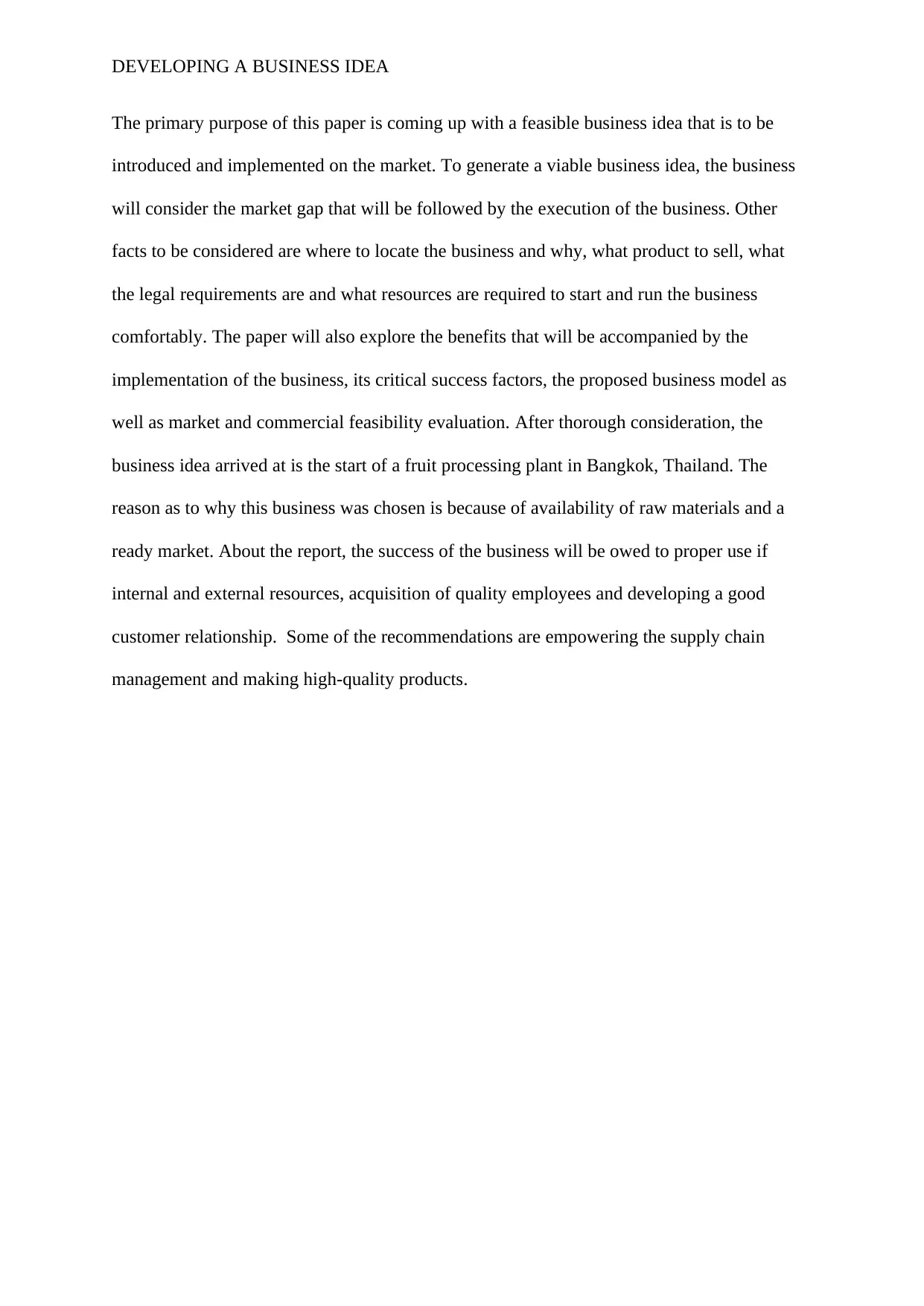
DEVELOPING A BUSINESS IDEA
The primary purpose of this paper is coming up with a feasible business idea that is to be
introduced and implemented on the market. To generate a viable business idea, the business
will consider the market gap that will be followed by the execution of the business. Other
facts to be considered are where to locate the business and why, what product to sell, what
the legal requirements are and what resources are required to start and run the business
comfortably. The paper will also explore the benefits that will be accompanied by the
implementation of the business, its critical success factors, the proposed business model as
well as market and commercial feasibility evaluation. After thorough consideration, the
business idea arrived at is the start of a fruit processing plant in Bangkok, Thailand. The
reason as to why this business was chosen is because of availability of raw materials and a
ready market. About the report, the success of the business will be owed to proper use if
internal and external resources, acquisition of quality employees and developing a good
customer relationship. Some of the recommendations are empowering the supply chain
management and making high-quality products.
The primary purpose of this paper is coming up with a feasible business idea that is to be
introduced and implemented on the market. To generate a viable business idea, the business
will consider the market gap that will be followed by the execution of the business. Other
facts to be considered are where to locate the business and why, what product to sell, what
the legal requirements are and what resources are required to start and run the business
comfortably. The paper will also explore the benefits that will be accompanied by the
implementation of the business, its critical success factors, the proposed business model as
well as market and commercial feasibility evaluation. After thorough consideration, the
business idea arrived at is the start of a fruit processing plant in Bangkok, Thailand. The
reason as to why this business was chosen is because of availability of raw materials and a
ready market. About the report, the success of the business will be owed to proper use if
internal and external resources, acquisition of quality employees and developing a good
customer relationship. Some of the recommendations are empowering the supply chain
management and making high-quality products.
⊘ This is a preview!⊘
Do you want full access?
Subscribe today to unlock all pages.

Trusted by 1+ million students worldwide
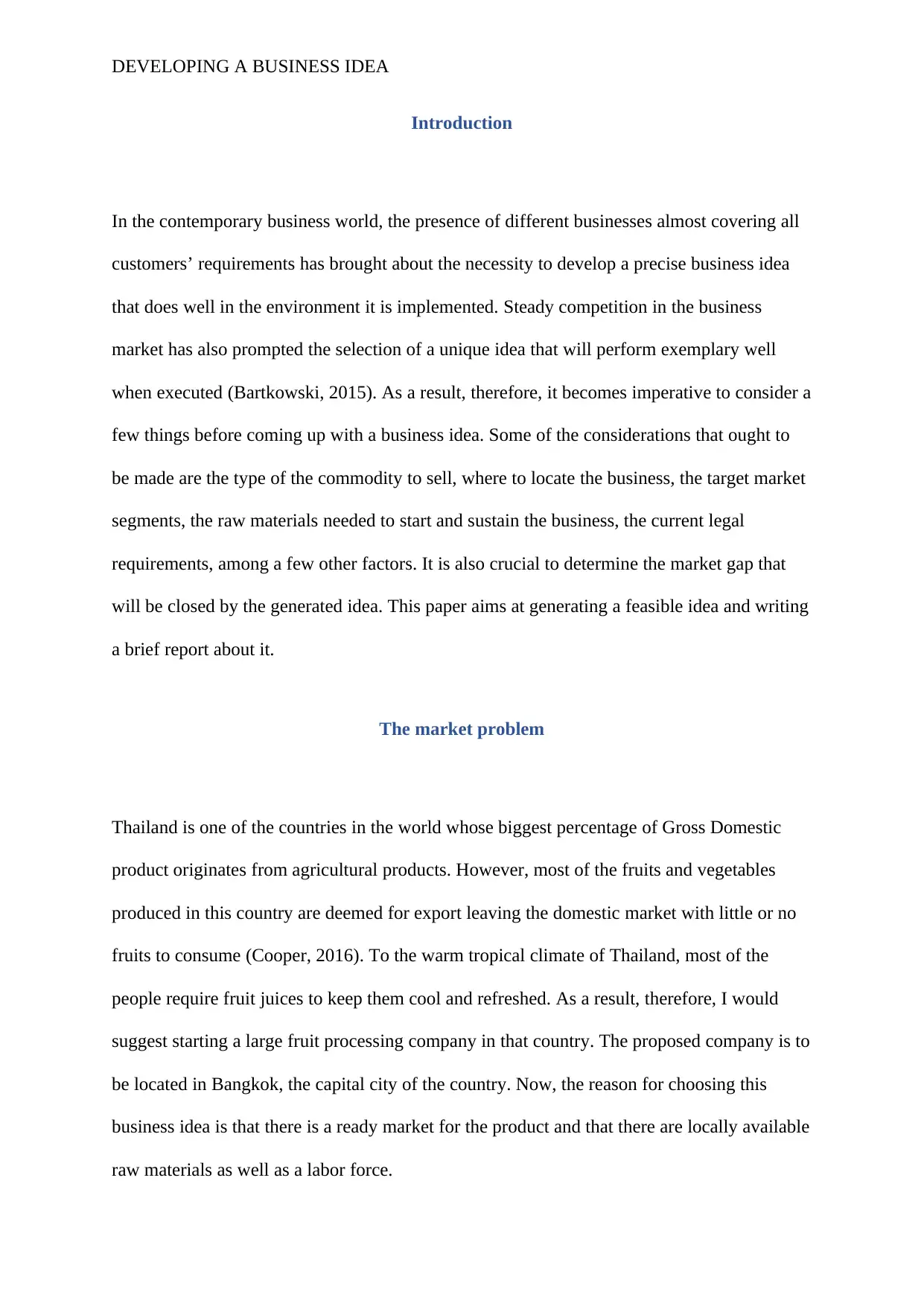
DEVELOPING A BUSINESS IDEA
Introduction
In the contemporary business world, the presence of different businesses almost covering all
customers’ requirements has brought about the necessity to develop a precise business idea
that does well in the environment it is implemented. Steady competition in the business
market has also prompted the selection of a unique idea that will perform exemplary well
when executed (Bartkowski, 2015). As a result, therefore, it becomes imperative to consider a
few things before coming up with a business idea. Some of the considerations that ought to
be made are the type of the commodity to sell, where to locate the business, the target market
segments, the raw materials needed to start and sustain the business, the current legal
requirements, among a few other factors. It is also crucial to determine the market gap that
will be closed by the generated idea. This paper aims at generating a feasible idea and writing
a brief report about it.
The market problem
Thailand is one of the countries in the world whose biggest percentage of Gross Domestic
product originates from agricultural products. However, most of the fruits and vegetables
produced in this country are deemed for export leaving the domestic market with little or no
fruits to consume (Cooper, 2016). To the warm tropical climate of Thailand, most of the
people require fruit juices to keep them cool and refreshed. As a result, therefore, I would
suggest starting a large fruit processing company in that country. The proposed company is to
be located in Bangkok, the capital city of the country. Now, the reason for choosing this
business idea is that there is a ready market for the product and that there are locally available
raw materials as well as a labor force.
Introduction
In the contemporary business world, the presence of different businesses almost covering all
customers’ requirements has brought about the necessity to develop a precise business idea
that does well in the environment it is implemented. Steady competition in the business
market has also prompted the selection of a unique idea that will perform exemplary well
when executed (Bartkowski, 2015). As a result, therefore, it becomes imperative to consider a
few things before coming up with a business idea. Some of the considerations that ought to
be made are the type of the commodity to sell, where to locate the business, the target market
segments, the raw materials needed to start and sustain the business, the current legal
requirements, among a few other factors. It is also crucial to determine the market gap that
will be closed by the generated idea. This paper aims at generating a feasible idea and writing
a brief report about it.
The market problem
Thailand is one of the countries in the world whose biggest percentage of Gross Domestic
product originates from agricultural products. However, most of the fruits and vegetables
produced in this country are deemed for export leaving the domestic market with little or no
fruits to consume (Cooper, 2016). To the warm tropical climate of Thailand, most of the
people require fruit juices to keep them cool and refreshed. As a result, therefore, I would
suggest starting a large fruit processing company in that country. The proposed company is to
be located in Bangkok, the capital city of the country. Now, the reason for choosing this
business idea is that there is a ready market for the product and that there are locally available
raw materials as well as a labor force.
Paraphrase This Document
Need a fresh take? Get an instant paraphrase of this document with our AI Paraphraser
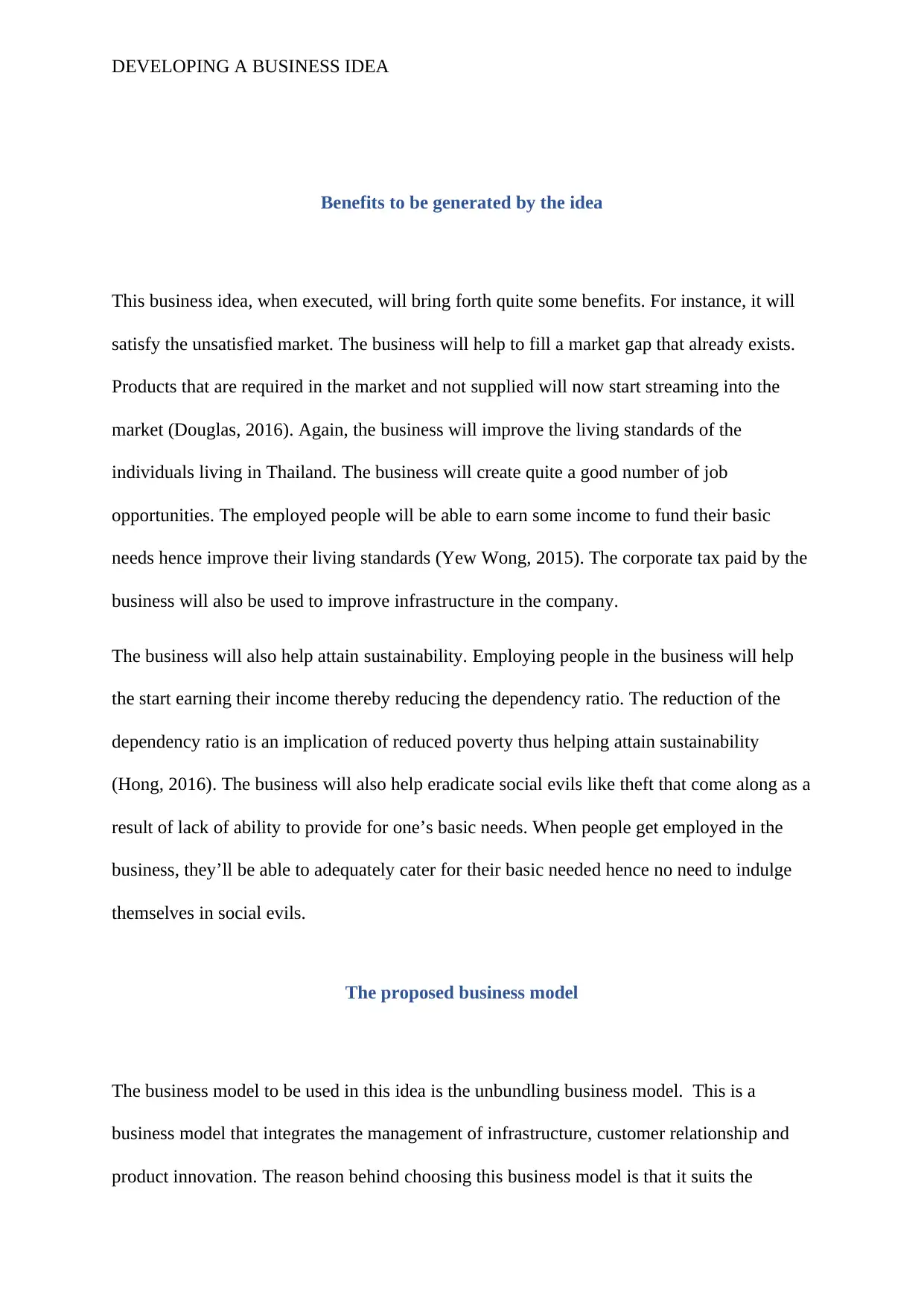
DEVELOPING A BUSINESS IDEA
Benefits to be generated by the idea
This business idea, when executed, will bring forth quite some benefits. For instance, it will
satisfy the unsatisfied market. The business will help to fill a market gap that already exists.
Products that are required in the market and not supplied will now start streaming into the
market (Douglas, 2016). Again, the business will improve the living standards of the
individuals living in Thailand. The business will create quite a good number of job
opportunities. The employed people will be able to earn some income to fund their basic
needs hence improve their living standards (Yew Wong, 2015). The corporate tax paid by the
business will also be used to improve infrastructure in the company.
The business will also help attain sustainability. Employing people in the business will help
the start earning their income thereby reducing the dependency ratio. The reduction of the
dependency ratio is an implication of reduced poverty thus helping attain sustainability
(Hong, 2016). The business will also help eradicate social evils like theft that come along as a
result of lack of ability to provide for one’s basic needs. When people get employed in the
business, they’ll be able to adequately cater for their basic needed hence no need to indulge
themselves in social evils.
The proposed business model
The business model to be used in this idea is the unbundling business model. This is a
business model that integrates the management of infrastructure, customer relationship and
product innovation. The reason behind choosing this business model is that it suits the
Benefits to be generated by the idea
This business idea, when executed, will bring forth quite some benefits. For instance, it will
satisfy the unsatisfied market. The business will help to fill a market gap that already exists.
Products that are required in the market and not supplied will now start streaming into the
market (Douglas, 2016). Again, the business will improve the living standards of the
individuals living in Thailand. The business will create quite a good number of job
opportunities. The employed people will be able to earn some income to fund their basic
needs hence improve their living standards (Yew Wong, 2015). The corporate tax paid by the
business will also be used to improve infrastructure in the company.
The business will also help attain sustainability. Employing people in the business will help
the start earning their income thereby reducing the dependency ratio. The reduction of the
dependency ratio is an implication of reduced poverty thus helping attain sustainability
(Hong, 2016). The business will also help eradicate social evils like theft that come along as a
result of lack of ability to provide for one’s basic needs. When people get employed in the
business, they’ll be able to adequately cater for their basic needed hence no need to indulge
themselves in social evils.
The proposed business model
The business model to be used in this idea is the unbundling business model. This is a
business model that integrates the management of infrastructure, customer relationship and
product innovation. The reason behind choosing this business model is that it suits the
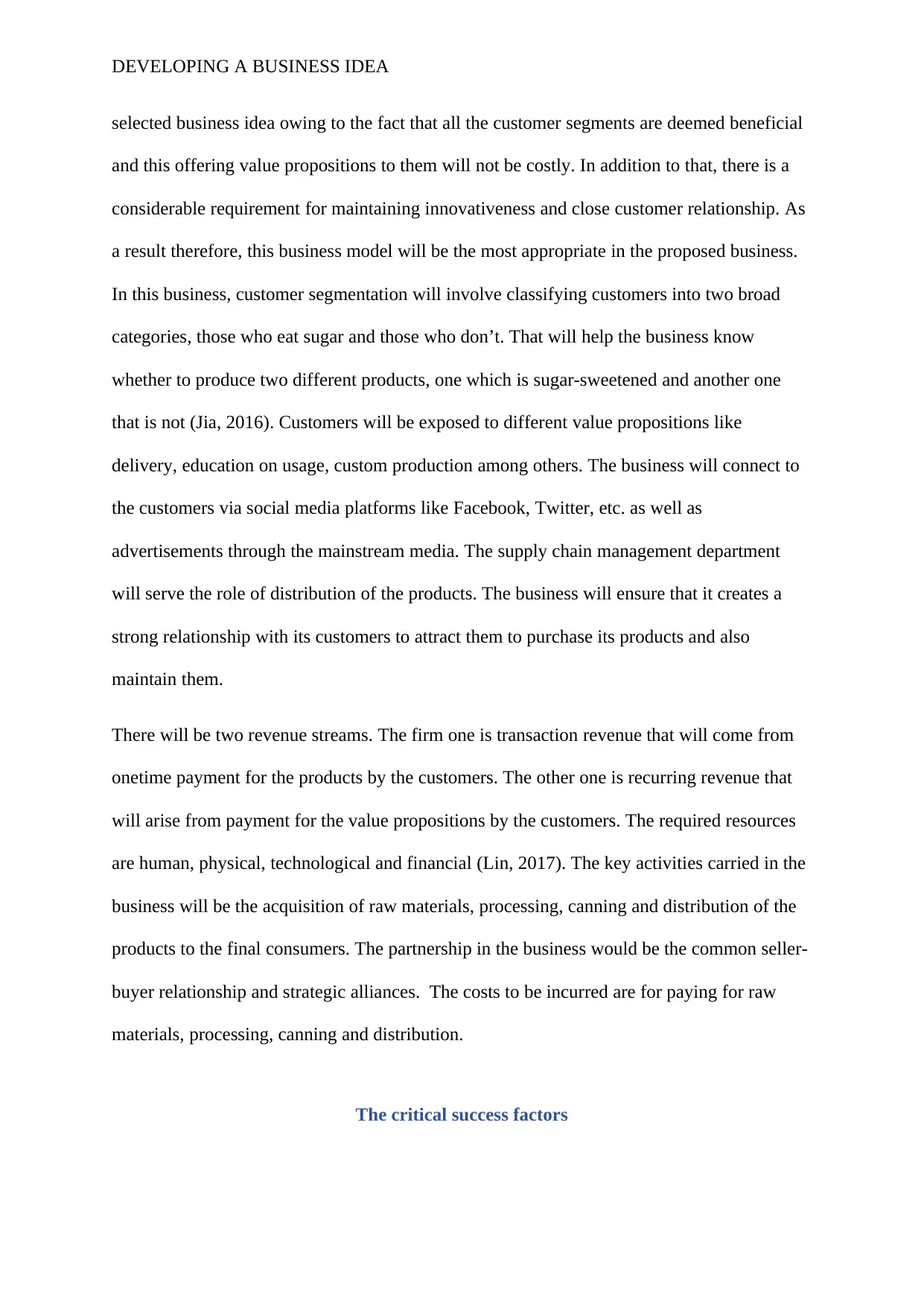
DEVELOPING A BUSINESS IDEA
selected business idea owing to the fact that all the customer segments are deemed beneficial
and this offering value propositions to them will not be costly. In addition to that, there is a
considerable requirement for maintaining innovativeness and close customer relationship. As
a result therefore, this business model will be the most appropriate in the proposed business.
In this business, customer segmentation will involve classifying customers into two broad
categories, those who eat sugar and those who don’t. That will help the business know
whether to produce two different products, one which is sugar-sweetened and another one
that is not (Jia, 2016). Customers will be exposed to different value propositions like
delivery, education on usage, custom production among others. The business will connect to
the customers via social media platforms like Facebook, Twitter, etc. as well as
advertisements through the mainstream media. The supply chain management department
will serve the role of distribution of the products. The business will ensure that it creates a
strong relationship with its customers to attract them to purchase its products and also
maintain them.
There will be two revenue streams. The firm one is transaction revenue that will come from
onetime payment for the products by the customers. The other one is recurring revenue that
will arise from payment for the value propositions by the customers. The required resources
are human, physical, technological and financial (Lin, 2017). The key activities carried in the
business will be the acquisition of raw materials, processing, canning and distribution of the
products to the final consumers. The partnership in the business would be the common seller-
buyer relationship and strategic alliances. The costs to be incurred are for paying for raw
materials, processing, canning and distribution.
The critical success factors
selected business idea owing to the fact that all the customer segments are deemed beneficial
and this offering value propositions to them will not be costly. In addition to that, there is a
considerable requirement for maintaining innovativeness and close customer relationship. As
a result therefore, this business model will be the most appropriate in the proposed business.
In this business, customer segmentation will involve classifying customers into two broad
categories, those who eat sugar and those who don’t. That will help the business know
whether to produce two different products, one which is sugar-sweetened and another one
that is not (Jia, 2016). Customers will be exposed to different value propositions like
delivery, education on usage, custom production among others. The business will connect to
the customers via social media platforms like Facebook, Twitter, etc. as well as
advertisements through the mainstream media. The supply chain management department
will serve the role of distribution of the products. The business will ensure that it creates a
strong relationship with its customers to attract them to purchase its products and also
maintain them.
There will be two revenue streams. The firm one is transaction revenue that will come from
onetime payment for the products by the customers. The other one is recurring revenue that
will arise from payment for the value propositions by the customers. The required resources
are human, physical, technological and financial (Lin, 2017). The key activities carried in the
business will be the acquisition of raw materials, processing, canning and distribution of the
products to the final consumers. The partnership in the business would be the common seller-
buyer relationship and strategic alliances. The costs to be incurred are for paying for raw
materials, processing, canning and distribution.
The critical success factors
⊘ This is a preview!⊘
Do you want full access?
Subscribe today to unlock all pages.

Trusted by 1+ million students worldwide
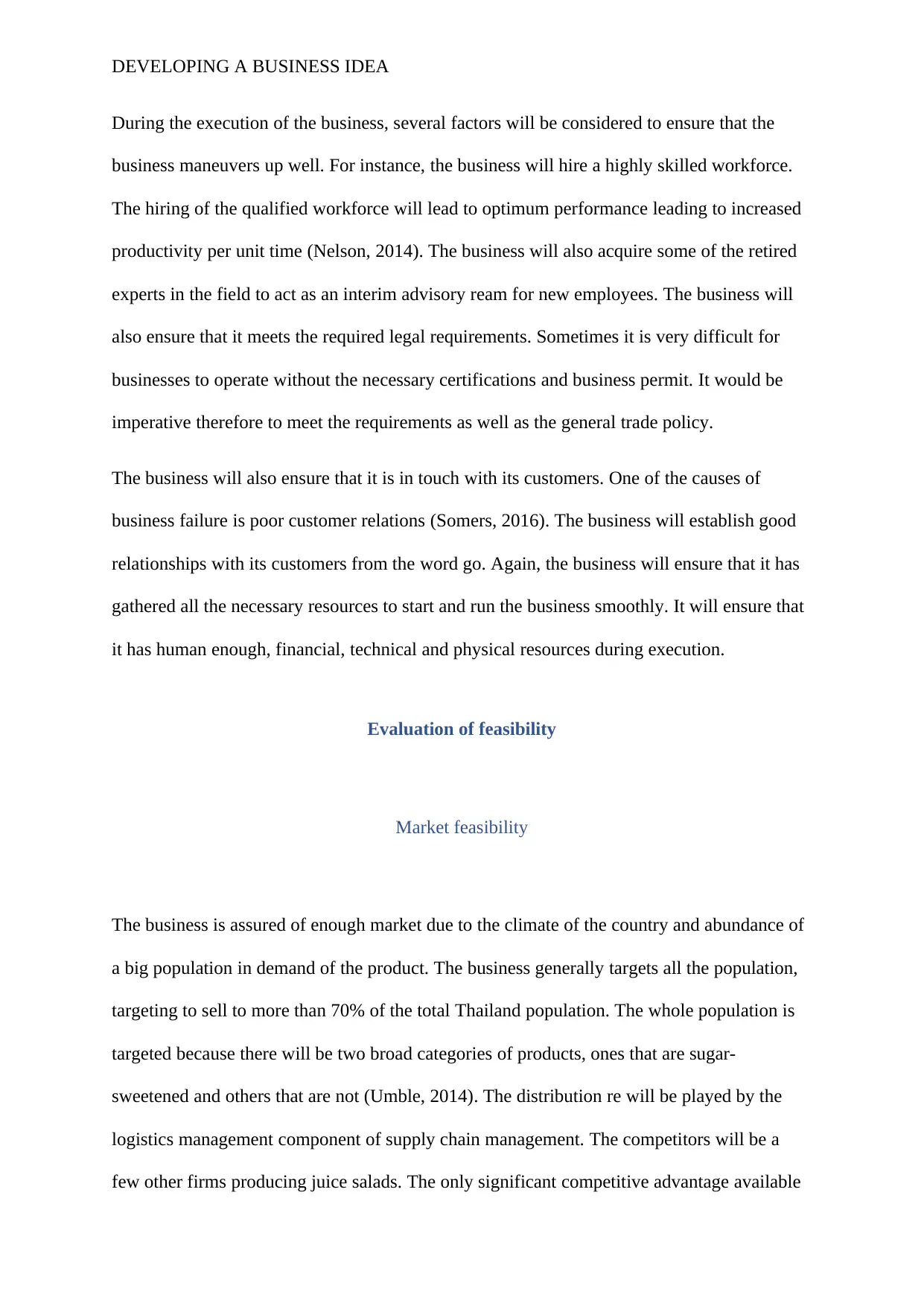
DEVELOPING A BUSINESS IDEA
During the execution of the business, several factors will be considered to ensure that the
business maneuvers up well. For instance, the business will hire a highly skilled workforce.
The hiring of the qualified workforce will lead to optimum performance leading to increased
productivity per unit time (Nelson, 2014). The business will also acquire some of the retired
experts in the field to act as an interim advisory ream for new employees. The business will
also ensure that it meets the required legal requirements. Sometimes it is very difficult for
businesses to operate without the necessary certifications and business permit. It would be
imperative therefore to meet the requirements as well as the general trade policy.
The business will also ensure that it is in touch with its customers. One of the causes of
business failure is poor customer relations (Somers, 2016). The business will establish good
relationships with its customers from the word go. Again, the business will ensure that it has
gathered all the necessary resources to start and run the business smoothly. It will ensure that
it has human enough, financial, technical and physical resources during execution.
Evaluation of feasibility
Market feasibility
The business is assured of enough market due to the climate of the country and abundance of
a big population in demand of the product. The business generally targets all the population,
targeting to sell to more than 70% of the total Thailand population. The whole population is
targeted because there will be two broad categories of products, ones that are sugar-
sweetened and others that are not (Umble, 2014). The distribution re will be played by the
logistics management component of supply chain management. The competitors will be a
few other firms producing juice salads. The only significant competitive advantage available
During the execution of the business, several factors will be considered to ensure that the
business maneuvers up well. For instance, the business will hire a highly skilled workforce.
The hiring of the qualified workforce will lead to optimum performance leading to increased
productivity per unit time (Nelson, 2014). The business will also acquire some of the retired
experts in the field to act as an interim advisory ream for new employees. The business will
also ensure that it meets the required legal requirements. Sometimes it is very difficult for
businesses to operate without the necessary certifications and business permit. It would be
imperative therefore to meet the requirements as well as the general trade policy.
The business will also ensure that it is in touch with its customers. One of the causes of
business failure is poor customer relations (Somers, 2016). The business will establish good
relationships with its customers from the word go. Again, the business will ensure that it has
gathered all the necessary resources to start and run the business smoothly. It will ensure that
it has human enough, financial, technical and physical resources during execution.
Evaluation of feasibility
Market feasibility
The business is assured of enough market due to the climate of the country and abundance of
a big population in demand of the product. The business generally targets all the population,
targeting to sell to more than 70% of the total Thailand population. The whole population is
targeted because there will be two broad categories of products, ones that are sugar-
sweetened and others that are not (Umble, 2014). The distribution re will be played by the
logistics management component of supply chain management. The competitors will be a
few other firms producing juice salads. The only significant competitive advantage available
Paraphrase This Document
Need a fresh take? Get an instant paraphrase of this document with our AI Paraphraser
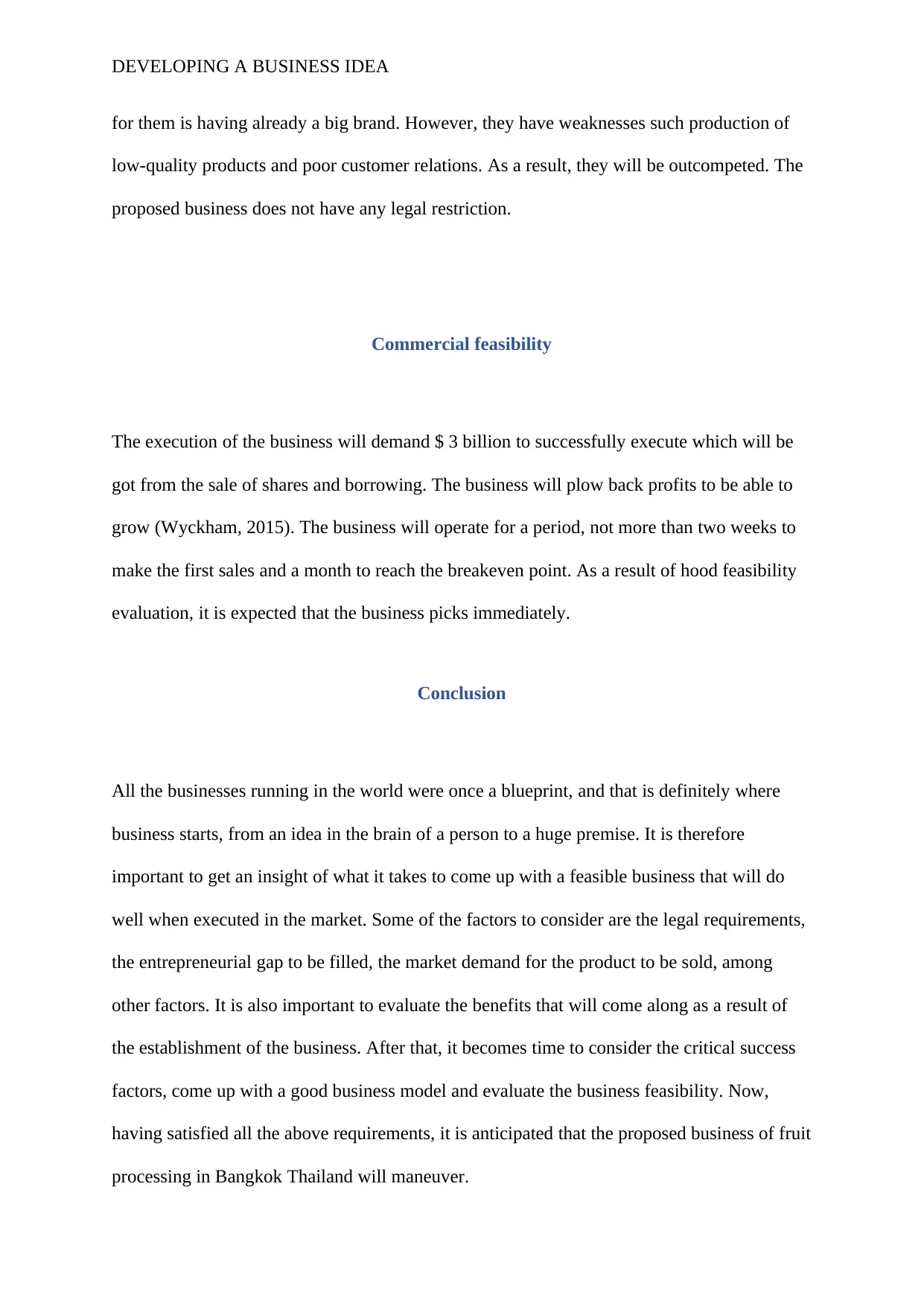
DEVELOPING A BUSINESS IDEA
for them is having already a big brand. However, they have weaknesses such production of
low-quality products and poor customer relations. As a result, they will be outcompeted. The
proposed business does not have any legal restriction.
Commercial feasibility
The execution of the business will demand $ 3 billion to successfully execute which will be
got from the sale of shares and borrowing. The business will plow back profits to be able to
grow (Wyckham, 2015). The business will operate for a period, not more than two weeks to
make the first sales and a month to reach the breakeven point. As a result of hood feasibility
evaluation, it is expected that the business picks immediately.
Conclusion
All the businesses running in the world were once a blueprint, and that is definitely where
business starts, from an idea in the brain of a person to a huge premise. It is therefore
important to get an insight of what it takes to come up with a feasible business that will do
well when executed in the market. Some of the factors to consider are the legal requirements,
the entrepreneurial gap to be filled, the market demand for the product to be sold, among
other factors. It is also important to evaluate the benefits that will come along as a result of
the establishment of the business. After that, it becomes time to consider the critical success
factors, come up with a good business model and evaluate the business feasibility. Now,
having satisfied all the above requirements, it is anticipated that the proposed business of fruit
processing in Bangkok Thailand will maneuver.
for them is having already a big brand. However, they have weaknesses such production of
low-quality products and poor customer relations. As a result, they will be outcompeted. The
proposed business does not have any legal restriction.
Commercial feasibility
The execution of the business will demand $ 3 billion to successfully execute which will be
got from the sale of shares and borrowing. The business will plow back profits to be able to
grow (Wyckham, 2015). The business will operate for a period, not more than two weeks to
make the first sales and a month to reach the breakeven point. As a result of hood feasibility
evaluation, it is expected that the business picks immediately.
Conclusion
All the businesses running in the world were once a blueprint, and that is definitely where
business starts, from an idea in the brain of a person to a huge premise. It is therefore
important to get an insight of what it takes to come up with a feasible business that will do
well when executed in the market. Some of the factors to consider are the legal requirements,
the entrepreneurial gap to be filled, the market demand for the product to be sold, among
other factors. It is also important to evaluate the benefits that will come along as a result of
the establishment of the business. After that, it becomes time to consider the critical success
factors, come up with a good business model and evaluate the business feasibility. Now,
having satisfied all the above requirements, it is anticipated that the proposed business of fruit
processing in Bangkok Thailand will maneuver.

DEVELOPING A BUSINESS IDEA
⊘ This is a preview!⊘
Do you want full access?
Subscribe today to unlock all pages.

Trusted by 1+ million students worldwide
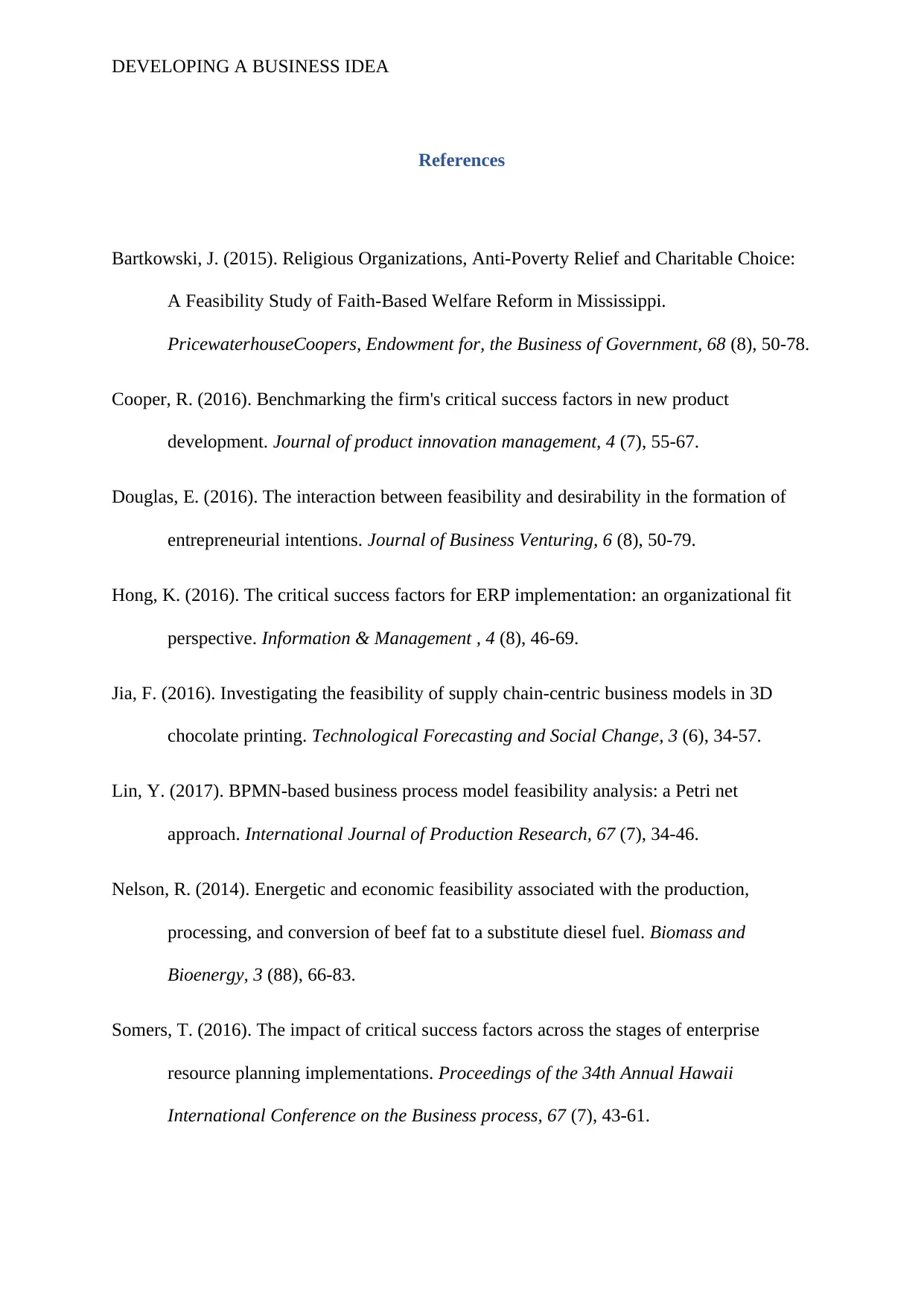
DEVELOPING A BUSINESS IDEA
References
Bartkowski, J. (2015). Religious Organizations, Anti-Poverty Relief and Charitable Choice:
A Feasibility Study of Faith-Based Welfare Reform in Mississippi.
PricewaterhouseCoopers, Endowment for, the Business of Government, 68 (8), 50-78.
Cooper, R. (2016). Benchmarking the firm's critical success factors in new product
development. Journal of product innovation management, 4 (7), 55-67.
Douglas, E. (2016). The interaction between feasibility and desirability in the formation of
entrepreneurial intentions. Journal of Business Venturing, 6 (8), 50-79.
Hong, K. (2016). The critical success factors for ERP implementation: an organizational fit
perspective. Information & Management , 4 (8), 46-69.
Jia, F. (2016). Investigating the feasibility of supply chain-centric business models in 3D
chocolate printing. Technological Forecasting and Social Change, 3 (6), 34-57.
Lin, Y. (2017). BPMN-based business process model feasibility analysis: a Petri net
approach. International Journal of Production Research, 67 (7), 34-46.
Nelson, R. (2014). Energetic and economic feasibility associated with the production,
processing, and conversion of beef fat to a substitute diesel fuel. Biomass and
Bioenergy, 3 (88), 66-83.
Somers, T. (2016). The impact of critical success factors across the stages of enterprise
resource planning implementations. Proceedings of the 34th Annual Hawaii
International Conference on the Business process, 67 (7), 43-61.
References
Bartkowski, J. (2015). Religious Organizations, Anti-Poverty Relief and Charitable Choice:
A Feasibility Study of Faith-Based Welfare Reform in Mississippi.
PricewaterhouseCoopers, Endowment for, the Business of Government, 68 (8), 50-78.
Cooper, R. (2016). Benchmarking the firm's critical success factors in new product
development. Journal of product innovation management, 4 (7), 55-67.
Douglas, E. (2016). The interaction between feasibility and desirability in the formation of
entrepreneurial intentions. Journal of Business Venturing, 6 (8), 50-79.
Hong, K. (2016). The critical success factors for ERP implementation: an organizational fit
perspective. Information & Management , 4 (8), 46-69.
Jia, F. (2016). Investigating the feasibility of supply chain-centric business models in 3D
chocolate printing. Technological Forecasting and Social Change, 3 (6), 34-57.
Lin, Y. (2017). BPMN-based business process model feasibility analysis: a Petri net
approach. International Journal of Production Research, 67 (7), 34-46.
Nelson, R. (2014). Energetic and economic feasibility associated with the production,
processing, and conversion of beef fat to a substitute diesel fuel. Biomass and
Bioenergy, 3 (88), 66-83.
Somers, T. (2016). The impact of critical success factors across the stages of enterprise
resource planning implementations. Proceedings of the 34th Annual Hawaii
International Conference on the Business process, 67 (7), 43-61.
Paraphrase This Document
Need a fresh take? Get an instant paraphrase of this document with our AI Paraphraser
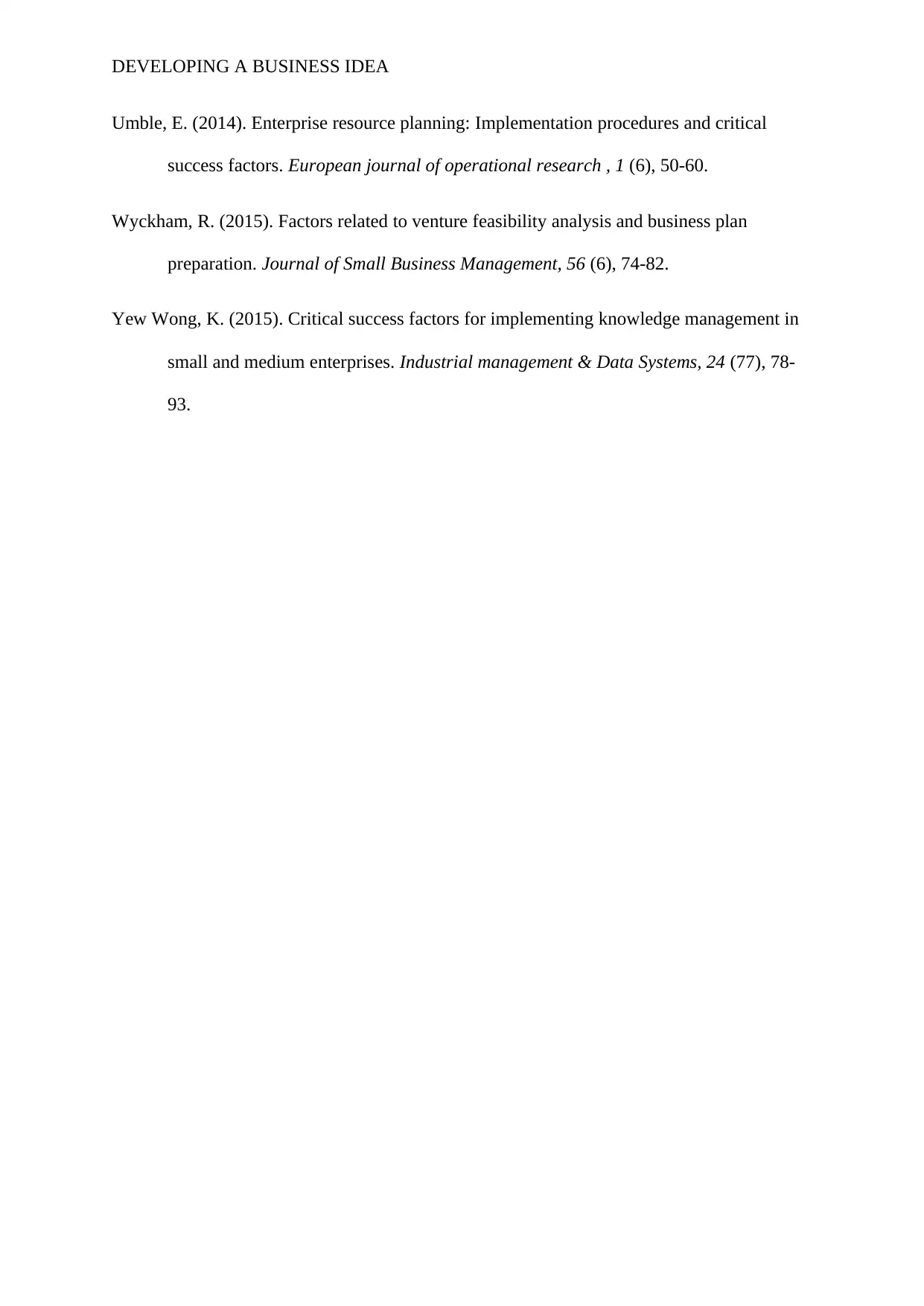
DEVELOPING A BUSINESS IDEA
Umble, E. (2014). Enterprise resource planning: Implementation procedures and critical
success factors. European journal of operational research , 1 (6), 50-60.
Wyckham, R. (2015). Factors related to venture feasibility analysis and business plan
preparation. Journal of Small Business Management, 56 (6), 74-82.
Yew Wong, K. (2015). Critical success factors for implementing knowledge management in
small and medium enterprises. Industrial management & Data Systems, 24 (77), 78-
93.
Umble, E. (2014). Enterprise resource planning: Implementation procedures and critical
success factors. European journal of operational research , 1 (6), 50-60.
Wyckham, R. (2015). Factors related to venture feasibility analysis and business plan
preparation. Journal of Small Business Management, 56 (6), 74-82.
Yew Wong, K. (2015). Critical success factors for implementing knowledge management in
small and medium enterprises. Industrial management & Data Systems, 24 (77), 78-
93.
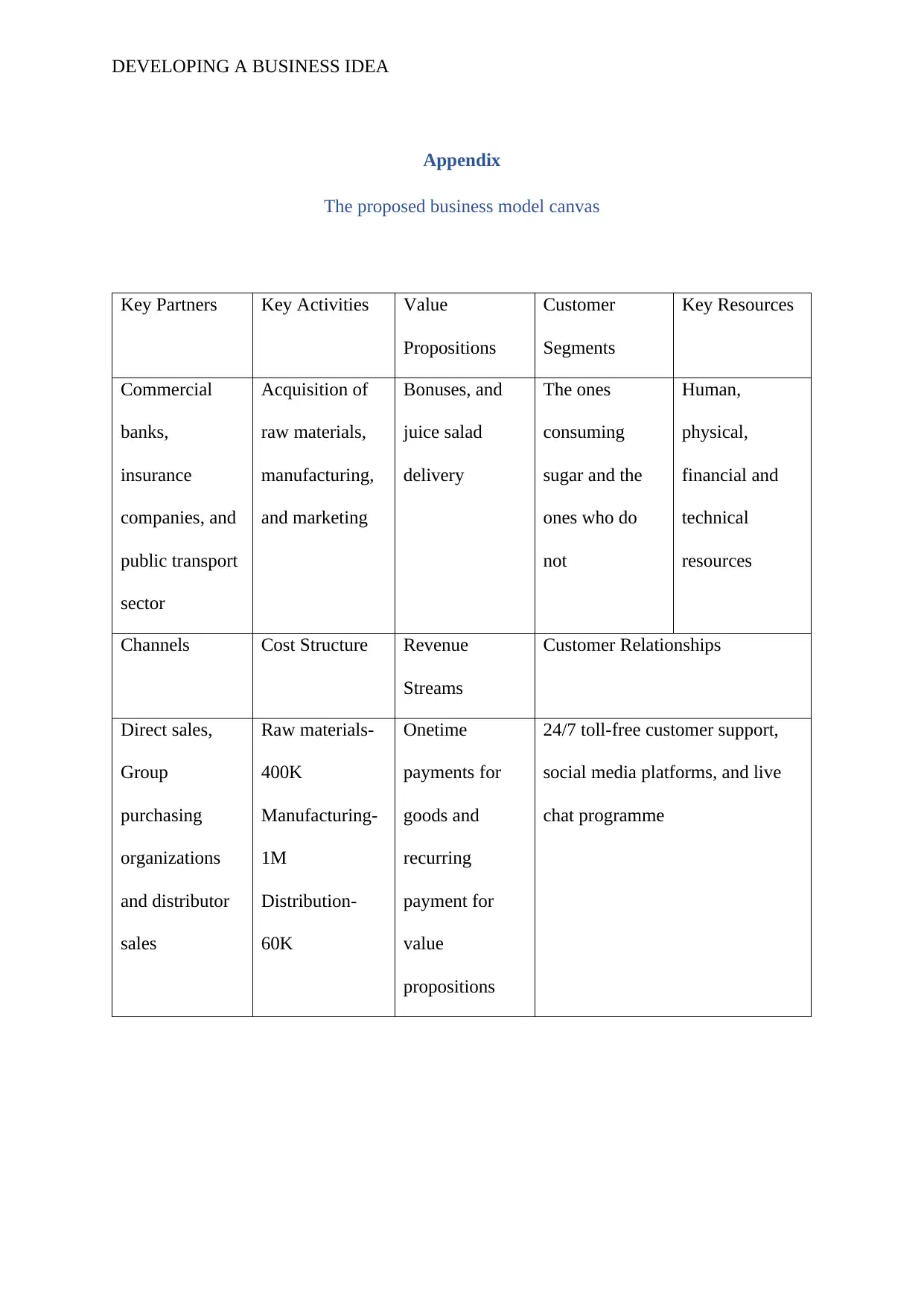
DEVELOPING A BUSINESS IDEA
Appendix
The proposed business model canvas
Key Partners Key Activities Value
Propositions
Customer
Segments
Key Resources
Commercial
banks,
insurance
companies, and
public transport
sector
Acquisition of
raw materials,
manufacturing,
and marketing
Bonuses, and
juice salad
delivery
The ones
consuming
sugar and the
ones who do
not
Human,
physical,
financial and
technical
resources
Channels Cost Structure Revenue
Streams
Customer Relationships
Direct sales,
Group
purchasing
organizations
and distributor
sales
Raw materials-
400K
Manufacturing-
1M
Distribution-
60K
Onetime
payments for
goods and
recurring
payment for
value
propositions
24/7 toll-free customer support,
social media platforms, and live
chat programme
Appendix
The proposed business model canvas
Key Partners Key Activities Value
Propositions
Customer
Segments
Key Resources
Commercial
banks,
insurance
companies, and
public transport
sector
Acquisition of
raw materials,
manufacturing,
and marketing
Bonuses, and
juice salad
delivery
The ones
consuming
sugar and the
ones who do
not
Human,
physical,
financial and
technical
resources
Channels Cost Structure Revenue
Streams
Customer Relationships
Direct sales,
Group
purchasing
organizations
and distributor
sales
Raw materials-
400K
Manufacturing-
1M
Distribution-
60K
Onetime
payments for
goods and
recurring
payment for
value
propositions
24/7 toll-free customer support,
social media platforms, and live
chat programme
⊘ This is a preview!⊘
Do you want full access?
Subscribe today to unlock all pages.

Trusted by 1+ million students worldwide
1 out of 12
Related Documents
Your All-in-One AI-Powered Toolkit for Academic Success.
+13062052269
info@desklib.com
Available 24*7 on WhatsApp / Email
![[object Object]](/_next/static/media/star-bottom.7253800d.svg)
Unlock your academic potential
Copyright © 2020–2025 A2Z Services. All Rights Reserved. Developed and managed by ZUCOL.





